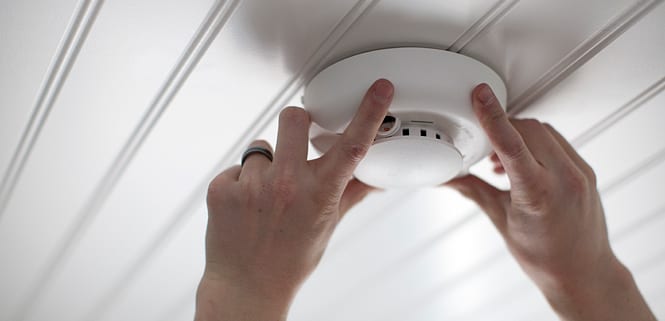Smoke Detectors and Smoke Detector Location
Smoke Detectors and Smoke Detector Location – A properly installed and maintained smoke alarm is the only thing in your home that can alert you and your family to a fire 24 hours a day, seven days a week. Industry experts at the NFPA have determined that in

Smoke Detector
a typical home fire, you only have three minutes to escape. There are many different brands of smoke alarms available on the market, but they fall under two basic types: ionization and photoelectric. Dual sensor smoke alarms are combination smoke alarms that combine ionization and photoelectric into one unit.
Ionization smoke detection is generally more responsive to flaming fires. Ionization-type smoke alarms have a small amount of radioactive material between two electrically charged plates, which ionizes the air and causes current to flow between the plates. When smoke enters the chamber, it disrupts the flow of ions, thus reducing the flow of current and activating the alarm. Sources of these fires may include flammable liquids or paper burning in a waste container. Most smoke alarms in use are of this type.
A photoelectric type smoke alarm consists of a light emitting diode and a light sensitive sensor in the sensing chamber. The presence of suspended products of combustion in the chamber scatters the light beam. This scattered light is detected and sets off the alarm. Sources of these fires may include cigarettes burning in couches or bedding.
Placement of smoke detectors is also very important. Home inspectors should be aware that according to the IRC 2009 smoke detectors should be installed in each sleeping room, outside each separate sleeping area in the immediate vicinity of the bedrooms and on each additional story of the dwelling , including basements and habitable attics but not including crawl spaces and uninhabitable attics. In new construction, minimum requirements are typically more stringent. All smoke detectors must be hooked directly to the electrical wiring, be interconnected and have a battery backup.
If the smoke alarm is battery powered, it will run on either a disposable 9-volt battery or a non-replaceable 10-year lithium battery. These batteries must be tested on a regular basis and, in most cases should be replaced at least once each year (except for lithium batteries).
Signature Home Inspection is a Certified Home Inspection service located in California serving Orange County, San Diego County, Los Angeles County, Riverside County, Santa Clara County, San Mateo County, San Francisco County, Contra Costa County, and San Bernardino County California.
www.signaturemore.com 888-860-2688




Leave a Reply
Want to join the discussion?Feel free to contribute!